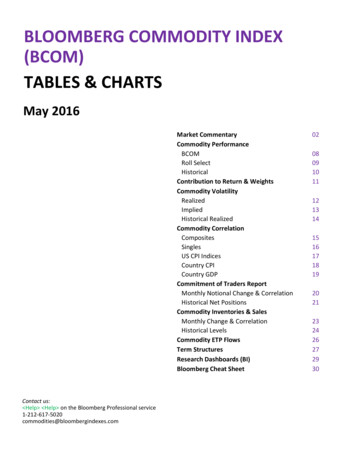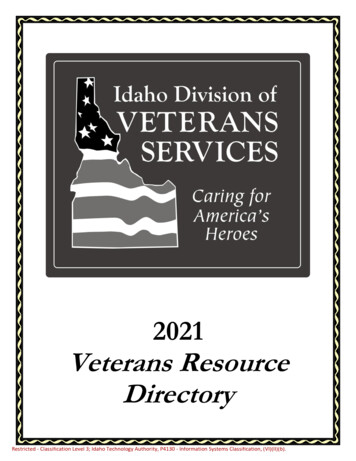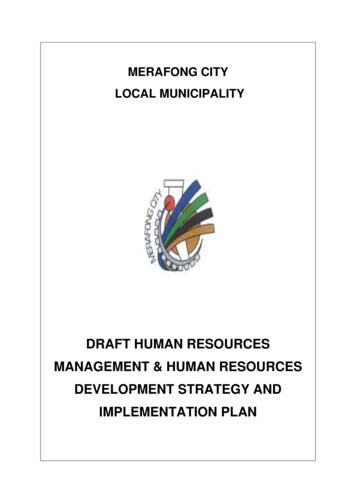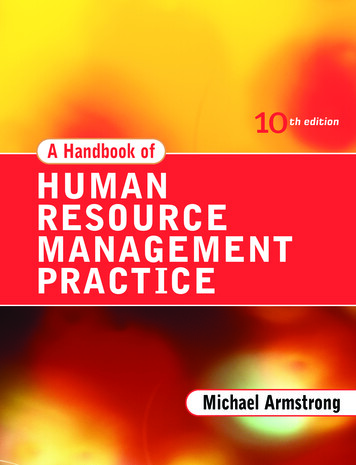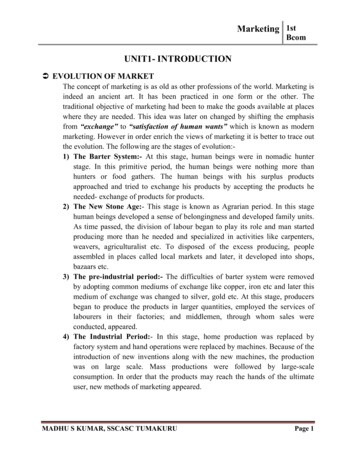
Transcription
BCOM 208- Human Resource ManagementUnit IIntroduction to HRM: concept, nature, scope, objectives and importance of HRM, role of HRMIn strategic management; Human Resource Development: concept and evolution; human capital;Emotional quotient; mentoring; ESOP; flexi-time; quality circles; Kaizen; TQM and six sigma,overview of Government policy since 1991 affecting human resources.Unit IIAcquisition of Human Resources: human resource planning: concept, significance andapproaches (social demand, rate of return and manpower requirement approach); human resourceForecasting: types and techniques; recruitment: policy, objectives, process and contemporaryMethods of recruitment (E-recruitment, recruitment process outsourcing etc.); selection: tests,Interview and selection decision; placement induction; job analysis, job design: behavioralconcerns, ergonomic considerations and flexible work schedules; introduction to employeeempowerment, managing protean careers, moonlighting phenomenon etc.Unit IIITraining and Development: introduction; training as a system; process; methods; trainingformats; developing training modules; evaluation: process; models; training wheel; managementdevelopment programmes; talent management and employee engagement; performance appraisal:purpose; benefits and methods; feedback system; HRD score card; managing compensation:concept; Behavioral issues; Ethics in compensation; employee benefits, health and social securitymeasures.Unit IVStrategic HRM: HRD audit, ethics and CSR; managing globalization; technology and HRM;work life balance and green HRM practices; knowledge management.
UNIT IIntroduction of HRMHuman resource management is that part of management which is directly concerned with thepeople employed in an organization. It involves procuring, developing and maintaining acompetent work force so as to achieve the goals of organization efficiently and effectively.In short, human resource management may be defined as obtaining, utilizing and maintaining aneffective and satisfied work force.Concept of HRMHuman Resource Management has come to be recognized as an inherent part of management,which is concerned with the human resources of an organization. Its objective is the maintenanceof better human relations in the organization by the development, application and evaluation ofpolicies, procedures and programmes relating to human resources to optimize their contributiontowards the realization of organizational objectives.In other words, HRM is concerned with getting better results with the collaboration of people. Itis an integral but distinctive part of management, concerned with people at work and theirrelationships within the enterprise. HRM helps in attaining maximum individual development,desirable working relationship between employees and employers, employees and employees,and effective modeling of human resources as contrasted with physical resources. It is therecruitment, selection, development, utilization, compensation and motivation of humanresources by the organization.Features of HRM1) Part of Management-Human resource management is an integral part of the managementprocess. It is inherent in all organizations because people comprise an essential part in everyorganization.2) Pervasive Function-Human resource management is a function that is performed by allmanagers at all levels of the organization. It is an essential part of the job of every manager.
Every manager has to deal with his subordinates to get things done. Therefore, human resourcemanagement is required in all functional areas such as finance, marketing, production etc.3) Concerned with People-Human resource management is concerned with people at work andtheir relationships. It deals with employees as individual and as groups.4) Wide Scope-The scope of human resource management is very wide. It includes a broadspectrum of activities like recruitment, selection, placement, training, transfer, promotion,appraisal and compensation of employees.Nature of HRMHuman Resource Management is a process of bringing people and organizations together so thatthe goals of each are met. The various features of HRM include: It is pervasive in nature as it is present in all enterprises. Its focus is on results rather than on rules. It tries to help employees develop their potential fully It encourages employees to give their best to the organization. It is all about people at work, both as individuals and groups. It tries to put people on assigned jobs in order to produce good results. It helps an organization meet its goals in the future by providing for competent and wellmotivated employees. It tries to build and maintain cordial relations between people working at various levels in theorganization. It is a multidisciplinary activity, utilizing knowledge and inputs drawn from psychology,economics, etc.
Scope of HRMThe scope of HRM is very wide:1. Personnel aspect-This is concerned with manpower planning, recruitment, selection,placement, transfer, promotion, training and development, layoff and retrenchment,remuneration, incentives, productivity etc.2. Welfare aspect-It deals with working conditions and amenities such as canteens, crèches, restand lunch rooms, housing, transport, medical assistance, education, health and safety, recreationfacilities, etc.3. Industrial relations aspect-This covers union-management relations, joint consultation,collective bargaining, grievance and disciplinary procedures, settlement of disputes, etc.Objectives of HRM To help the organization reach its goals. To ensure effective utilization and maximum development of human resources. To ensure respect for human beings. To ensure reconciliation of individual goals with those of the organization. To achieve and maintain high morale among employees. To provide the organization with well-trained and well-motivated employees. To increase to the fullest the employee's job satisfaction and self-actualization. To develop and maintain a quality of work.Importance of HRM1) Recruitment and TrainingThis is one of the major responsibilities of the human resource team. The HR managerscome up with plans and strategies for hiring the right kind of people. They design thecriteria which is best suited for a specific job description. Their other tasks related to
recruitment include formulating the obligations of an employee and the scope of tasksassigned to him or her. Based on these two factors, the contract of an employee with thecompany is prepared. When needed, they also provide training to the employeesaccording to the requirements of the organization. Thus, the staff members get theopportunity to sharpen their existing skills or develop specialized skills which in turn,will help them to take up some new roles.2) Performance AppraisalsHRM encourages the people working in an organization, to work according to theirpotential and gives them suggestions that can help them to bring about improvement in it.The team communicates with the staff individually from time to time and provides all thenecessary information regarding their performances and also defines their respectiveroles. This is beneficial as it enables them to form an outline of their anticipated goals inmuch clearer terms and thereby, helps them execute the goals with best possible efforts.Performance appraisals, when taken on a regular basis, motivate the employees.3) Maintaining Work AtmosphereThis is a vital aspect of HRM because the performance of an individual in an organisationis largely driven by the work atmosphere or work culture that prevails at the workplace.A good working condition is one of the benefits that the employees can expect from anefficient human resource team. A safe, clean and healthy environment can bring out thebest in an employee. A friendly atmosphere gives the staff members’ job satisfaction aswell.4) Managing DisputesIn an organization, there are several issues on which disputes may arise between theemployees and the employers. You can say conflicts are almost inevitable. In such ascenario, it is the human resource department which acts as a consultant and mediator tosort out those issues in an effective manner. They first hear the grievances of theemployees. Then they come up with suitable solutions to sort them out. In other words,they take timely action and prevent things from going out of hands.5) Developing Public RelationsThe responsibility of establishing good public relations lies with the HRM to a greatextent. They organize business meetings, seminars and various official gatherings on
behalf of the company in order to build up relationships with other business sectors.Sometimes, the HR department plays an active role in preparing the business andmarketing plans for the organization too.Any organization, without a proper setup for HRM is bound to suffer from seriousproblems while managing its regular activities. For this reason, today, companies mustput a lot of effort and energy into setting up a strong and effective HRM.Functions of HRMRole of HRM in strategic ManagementRole in Strategy Formulation: HRM is in a unique position to supply competitive intelligencethat may be useful in strategy formulation. Details regarding advanced incentive plans used bycompetitors, opinion survey data from employees, elicit information about customer complaints,information about pending legislation etc. can be provided by HRM. Unique HR capabilitiesserve as a driving force in strategy formulation.
Role in Strategy Implementation: HRM supplies the company with a competent and willingworkforce for executing strategies. It is important to remember that linking strategy and HRMeffectively requires more than selection from a series of practice choices. The challenge is todevelop a configuration of HR practice choices that help implement the organization’s strategyand enhance its competitiveness.Human Resource DevelopmentConcept and Meaning of HRDThe active resource of an organization is human resource. Other resources remain inactive unlessthere are competent people to utilize the available resources for the production of goods andservices. Human brain has a limitless energy to think and act in a productive way. Hence,competent and qualified human resource is a key factor of organizational success. In this regard,the emergence of human resource development (HRD) plays a vital role in enhancing theentrepreneurial skill of people.Human Resource Development (HRD) is a process of developing skills, competencies,knowledge and attitudes of people in an organization. The people become human resource onlywhen they are competent to perform organizational activities. Therefore, HRD ensures that theorganization has such competent human resource to achieve its desired goals and objectives.HRD imparts the required knowledge and skill in them through effective arrangement of trainingand development programs. HRD is an integral part of Human Resource Management (HRM)which is more concerned with training and development, career planning and development andthe organization development. The organization has to understand the dynamics of HR andattempt to cope with changing situation in order to deploy its HR effectively and efficiently. AndHRD helps to reach this target.Hence, HRD is a conscious and proactive approach applied by employers which seeks tocapacitate employees through training and development to give their maximum to theorganization and to fully use their potential to develop themselves.
HRD concept was first introduced by Leonard Nadler in 1969 in a conference in US. “Hedefined HRD as those learning experience which are organized, for a specific time, and designedto bring about the possibility of behavioral change”.Human Resource Development (HRD) is the frameworks for helping employees develop theirpersonal and organizational skills, knowledge, and abilities. Human Resource Developmentincludes such opportunities as employee training, employee career development, performancemanagement and development, coaching, mentoring, succession planning, key employeeidentification, tuition assistance, and organization development.According to M.M. Khan, "Human resource development is the across of increasing knowledge,capabilities and positive work attitudes of all people working at all levels in a businessundertaking."Nature of HRD1. HRD is a continuous process2. HRD concerned with behavioral knowledge.3. HRD is a well integrated system4. HRD provides better quality of life.5. HRD focuses on all round development of human resources.Importance of HRD1. HRD Develops Competent HRHRD develops the skills and knowledge of individual; hence, it helps to provide competent andefficient HR as per the job requirement. To develop employment's skill and competencies,different training and development programs are launched.2. HRD Creates Opportunity for Career Development
HRD helps to grasp the career development opportunities through development of human skillsand knowledge. Career development consists of personal development efforts through a propermatch between training and development opportunities with employee’s need.3. Employ CommitmentTrained and efficient employees are committed towards their jobs which is possible throughHRD. If employees are provided with proper training and development opportunities, they willfeel committed to the work and the organization.4. Job SatisfactionWhen people in the organization are well oriented and developed, they show higher degree ofcommitment in actual work place. This inspires them for better performance, which ultimatelyleads to job satisfaction.5. Change ManagementHRD facilitates planning, and management of change in an organization. It also managesconflicts through improved labor management relation. It develops organizational health, cultureand environment which lead to change management.6. Opportunities for Training and DevelopmentTrainings and development programs are tools of HRD. They provide opportunity for employee'sdevelopment by matching training needs with organizational requirement. Moreover, HRDfacilitates integrated growth of employees through training and development activities.7. Performance ImprovementHRD develops necessary skills and abilities required to perform organizational activities. As aresult of which, employees can contribute for better performance in an organization. This leadsto greater organizational effectiveness.
Evolution of HRD Early apprenticeship programs Early vocational education programs Early factory schools Early training for unskilled/semiskilled Human relations movement Establishment of training profession Emergence of HRDPrehistoryThe term "human resources" was coined only in the 20th century. However, the human racedeveloped employee selection processes long before that. Even during the prehistoric period,humans carefully considered a candidate's qualification before choosing him for a leadershipposition. In addition, the earliest human beings placed high importance on passing downnecessary knowledge. Human resource development relies on education, which involvestransmitting essential materials to employees so they can do their jobs better.Ancient HistoryAs human civilization continued to develop, so did the desire to improve employee performanceand knowledge. Historians have found evidence of employment screening exams dating back to1115 B.C. in China. The ancient Greeks and Babylonians created the apprenticeship system,which trained entry level employees in a particular trade. Apprenticeships continued well into themiddle Ages.
The Industrial RevolutionIn the late 18th century, Europe and America's economies shifted from agriculture tomanufacturing. Inventors developed mechanisms to speed up production. However,mechanization led to injuries, a monotonous work environment and low wages in favor of moreefficient production. Some employers realized productivity correlated strongly to workersatisfaction and attempted to improve training and salary.Human Relations MovementWorld War I brought about huge changes in the labor market. After World War I, thegovernment and businesses realized that employees would no longer contribute to the economyif mistreated. In 1928, social scientist Elton Mayo began researching the effect of better workingconditions on employees. Not surprisingly, workers under improved conditions produced more.Mayo discovered that under better conditions, employees worked as a team and generated ahigher output. He promoted stronger human relations between subordinates and supervisors,which he called "the Human Relations movement."Human Resources ApproachBy the 1960s, managers and researchers realized that just because an employee has betterworking conditions does not mean he will work harder. Instead, a new theory emerged. Bothbosses and social scientists concluded that each worker has individual needs and requires a morepersonalized form of motivation in order to produce more. Businesses began treating employeesas assets or resources, which needed cultivation and encouragement in order for the company tosucceed.Developing ResourcesDuring the last decades of the 20th century, supervisors began to focus on bringingorganizational and individual employee goals closer together. To do this, managers strove tomake work meaningful. Upper management gave human resources professionals theresponsibility of optimizing employee skills to create a more valuable, skilled workforce. Thistrend has prevailed into the 21st century, with human resource departments emphasizing skilldevelopment and training for employees.
Human CapitalA measure of the economic value of an employee's skill set. This measure builds on the basicproduction input of labor measure where all labor is thought to be equal. The concept of humancapital recognizes that not all labor is equal and that the quality of employees can be improvedby investing in them. The education, experience and abilities of an employee have an economicvalue for employers and for the economy as a whole.Emotional QuotientEQ actually stands for Emotional Intelligence Quotient. Much like an intelligence quotient, orIQ, an EQ is said to be a measure of a person’s emotional intelligence. However, there is muchdebate surrounding the legitimacy of a definition of emotional intelligence quotient, primarilybecause there is no standard against which it can be measured.Research on EQ began with Yale psychologist Peter Salovey and John Mayer of the Universityof New Hampshire in the late 1980s. EQ is a concept that was further popularized by DanielGoleman, another well-respected psychologist, who has written many books on the subject and isco-chair of The Consortium for Research on Emotional Intelligence in Organizations. Whilethese and many other psychology experts view EQ as a scientific study of social behavior andrelationships, the actual science behind measuring EQ is often convoluted at best.MentoringMentoring is most often defined as a professional relationship in which an experienced person(the mentor) assists another (the mentoree) in developing specific skills and knowledge that willenhance the less-experienced person’s professional and personal growth.What does a mentor do? The following are among the mentor’s functions: Teaches the mentoree about a specific issue Coaches the mentoree on a particular skill Facilitates the mentoree’s growth by sharing resources and networks
Challenges the mentoree to move beyond his or her comfort zone Creates a safe learning environment for taking risks. Focuses on the mentoree’s total developmentESOPAn Employee Stock Ownership Plan (ESOP) is an employee benefit plan which makes theemployees of company owners of stock in that company. Several features make ESOPs uniqueas compared to other employee benefit plans. First, only an ESOP is required by law to investprimarily in the securities of the sponsoring employer. Second, an ESOP is unique amongqualified employee benefit plans in its ability to borrow money. As a result, "leveraged ESOPs"may be used as a technique of corporate finance.The benefits for the company include increased cash flow, tax savings, and increasedproductivity from highly motivated workers. The main benefit for the employees is the ability toshare in the company's success. Due to the tax benefits, the administration of ESOPs is regulated,and numerous restrictions apply. It is also called stock purchase planFlexi-TimeFlexi time (or flextime, flexi-time, originally derived from the German word Gleitzeit whichliterally means "sliding time") is a variable work schedule, in contrast to traditional workarrangements requiring employees to work a standard 9 a.m. to 5 p.m. day. Its invention isusually credited to William Henning. Under flextime, there is typically a core period (ofapproximately 50% of total working time/working day) of the day, when employees are expectedto be at work (for example, between 11 a.m. and 3 p.m.), while the rest of the working day is"flexi time", in which employees can choose when they work, subject to achieving total daily,weekly or monthly hours in the region of what the employer expects, and subject to thenecessary work being done.A flextime policy allows staff to determine when they will work, while a flex place policy allowsstaff to determine where they will work. Its practical realization can mainly be attributed to theentrepreneur Wilhelm Haller who founded Hengstler Gleitzeit, and later "Inter flex
Datensysteme GmbH" in Southern Germany, where today a number of companies offer Flexitime (Gleitzeit) solutions which have grown out of his initiative
Quality CirclesQuality Circles are (informal) groups of employees who voluntarily meet together on a regularbasis to identify, define, analyze and solve work related problems.Usually the members of a particular team (quality circle) should be from the same work area orwho do similar work so that the problems they select will be familiar to all of them. In addition,interdepartmental or cross functional quality circles may also be formed.An ideal size of quality circle is seven to eight members. But the number of members in a qualitycircle can vary.Objectives of Quality Circles Promote job involvement Create problem solving capability Improve communication Promote leadership qualities Promote personal development Develop a greater awareness for cleanliness Develop greater awareness for safety Improve morale through closer identity of employee objectives with organization'sobjectives Reduce errors. Enhance quality Inspire more effective team work
KaizenKaizen was created in Japan following World War II. The word Kaizen means "continuousimprovement". It comes from the Japanese words 改 ("kai") which means "change" or "tocorrect" and 善 ("zen") which means "good".Kaizen is a system that involves every employee - from upper management to the cleaning crew.Everyone is encouraged to come up with small improvement suggestions on a regular basis. Thisis not a once a month or once a year activity. It is continuous. Japanese companies, such asToyota and Canon, a total of 60 to 70 suggestions per employee per year are written down,shared and implemented.In most cases these are not ideas for major changes. Kaizen is based on making little changes ona regular basis: always improving productivity, safety and effectiveness while reducing waste.Suggestions are not limited to a specific area such as production or marketing. Kaizen is basedon making changes anywhere that improvements can be made. Western philosophy may besummarized as, "if it ain't broke, don't fix it." The Kaizen philosophy is to "do it better, make itbetter, and improve it even if it isn't broken, because if we don't, we can't compete with thosewho do."TQMTotal quality management or TQM is an integrative philosophy of management for continuouslyimproving the quality of products and processes.TQM functions on the premise that the quality of products and processes is the responsibility ofeveryone who is involved with the creation or consumption of the products or services offered byan organization. In other words, TQM capitalizes on the involvement of management, workforce,suppliers, and even customers, in order to meet or exceed customer expectations. Considering thepractices of TQM as discussed in six empirical studies, Cua, McKone, and Schroeder (2001)identified the nine common TQM practices as cross-functional product design, processmanagement, supplier quality management, customer involvement, information and feedback,committed leadership, strategic planning, cross-functional training, and employee involvement.
Six SigmaSix Sigma seeks to improve the quality of process outputs by identifying and removing thecauses of defects (errors) and minimizing variability in manufacturing and business processes. Ituses a set of quality management methods, including statistical methods, and creates a specialinfrastructure of people within the organization ("Black Belts", "Green Belts", etc.) who areexperts in these methods. Each Six Sigma project carried out within an organization follows adefined sequence of steps and has quantified financial targets (cost reduction and/or profitincrease).The term Six Sigma originated from terminology associated with manufacturing, specificallyterms associated with statistical modeling of manufacturing processes. The maturity of amanufacturing process can be described by a sigma rating indicating its yield, or the percentageof defect-free products it creates. A six sigma process is one in which 99.99966% of the productsmanufactured are statistically expected to be free of defects (3.4 defects per million). Motorolaset a goal of "six sigma" for all of its manufacturing operations, and this goal became a bywordfor the management and engineering practices used to achieve it.Overview of Government policy since 1991 affecting Human ResourcesHuman resources practices regularly involve rights and activities protected by employment lawsthat confer employee rights and impose legal responsibilities on employers. Human resourcesprofessionals must know current federal, state and local employment laws that apply to their sizeand type of business in their geographic location. Common employee rights protected underemployment laws include nondiscrimination and equal employment opportunity, freedom to joinand form unions, minimum standards for terms and conditions of employment, and the right toprivacy.It provides a survey of employment laws, including employment discrimination (such asprotected class, disparate impact, disparate treatment, retaliation); military leave; drug-freeworkplace legal issues; workplace violence; the Family and Medical Leave Act of 1993(FMLA); the Americans with Disabilities Act of 1990 (ADA); negligent referral; negligenthiring; negligent retention; and employee references. Human Resource Management (HRM)
involves compliance and litigation avoidance. These modules underscore the importance for HRprofessionals to understand these legal issues.Anti-DiscriminationTitle VII of the Civil Rights Act of 1964 prohibits discrimination against employees on the basisof "race, color, religion, sex, or national origin." The regulations apply to employers who had 15or more employees on the payroll, every day for at least 20 weeks during the current or priorcalendar year. Employers cannot refuse to hire an employee, dismiss him from employment, orotherwise discriminate against the employee for one of these reasons. Likewise, the employermay not retaliate against an employee for making a charge of discrimination under the Act. TheAge Discrimination in Employment Act extends the prohibition of discrimination in hiring andfiring actions to employees aged 40 and older. This legislation does not apply to businesses withless than 20 workers.Wage and HourThe Fair Labor Standards Act (FLSA) establishes the amount of the federal minimum wage,which is revised on a periodic basis. Because several states have legislation establishing aminimum wage higher than the federal minimum, HR professionals should continuously verifythe accuracy of the amount paid to employees. In addition to extensive child labor regulations,FLSA regulations also require all covered employees to be paid overtime for any hours workedover 40 in a workweek. Several exemptions to the FLSA exist, and HR managers should ensureemployees are classified appropriately for their job duties. Failure to comply with the FLSA canlead to penalties and back pay for up to two years — or three, if the violation is deemed to bewillful. Don't assume that your business is too small to be covered — the FLSA does not specifya minimum number of employees.Leave ProvisionsThe federal Family and Medical Leave Act (FMLA) provides eligible employees with the abilityto take up to 12 weeks of unpaid leave in a 12-month period for a variety of circumstances, suchas the serious health condition of the employee, his spouse or child, bonding with a new baby ora qualifying exigency related to active military service. Up to 26 weeks of leave are permitted for
an employee who is caring for an eligible service member. Employees are entitled to jobprotection during the absence and their health coverage continues as if they had remained atwork. The burden is on the employer to recognize that FMLA time is appropriate — theemployee does not even have to mention FMLA to request the leave — and HR staff should trainmanagers and supervisors on the eligible reasons for leave.Medical and DisabilityVarious federal laws dictate how the employer must treat an employee with a disability ormedical condition. The Americans with Disabilities Act prohibits an employer fromdiscriminating against employees on the basis of a disability or perceived disability. The Act alsorequires employers to make reasona
In short, human resource management may be defined as obtaining, utilizing and maintaining an effective and satisfied work force. Concept of HRM Human Resource Management has come to be recognized as an inherent part of management, which is concerned with the human resources of an organization. Its objective is the maintenance
